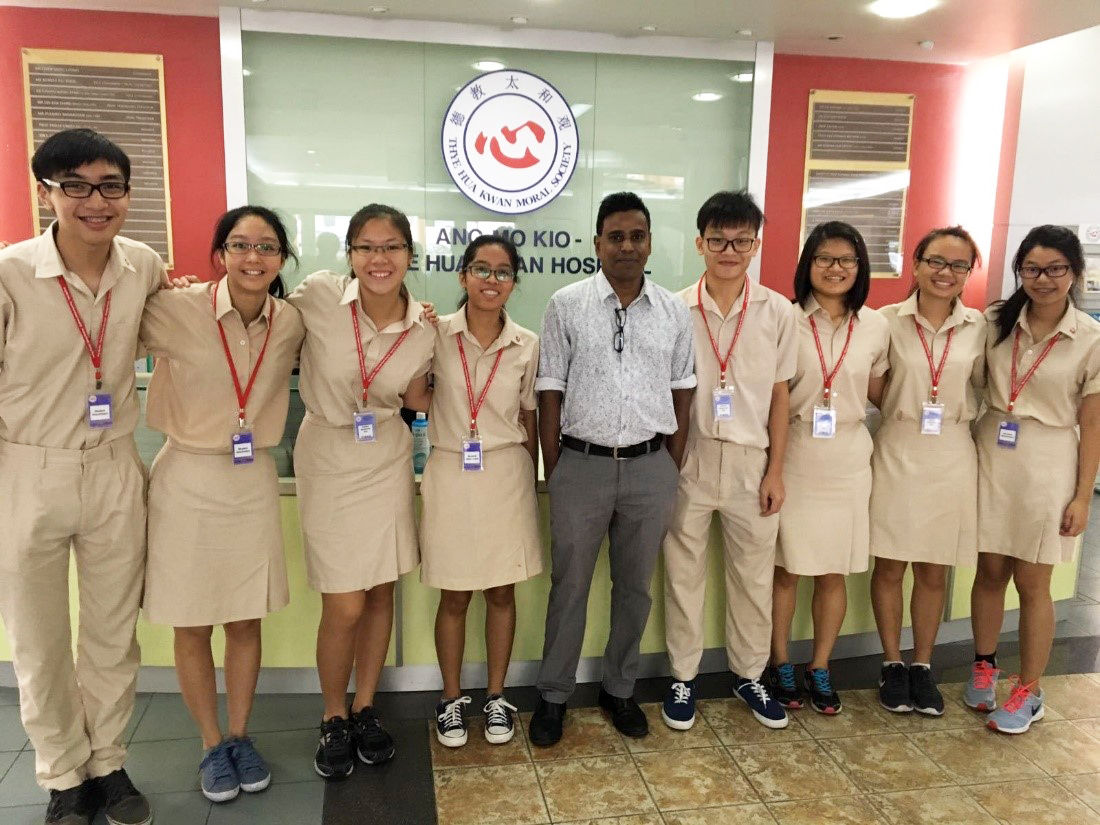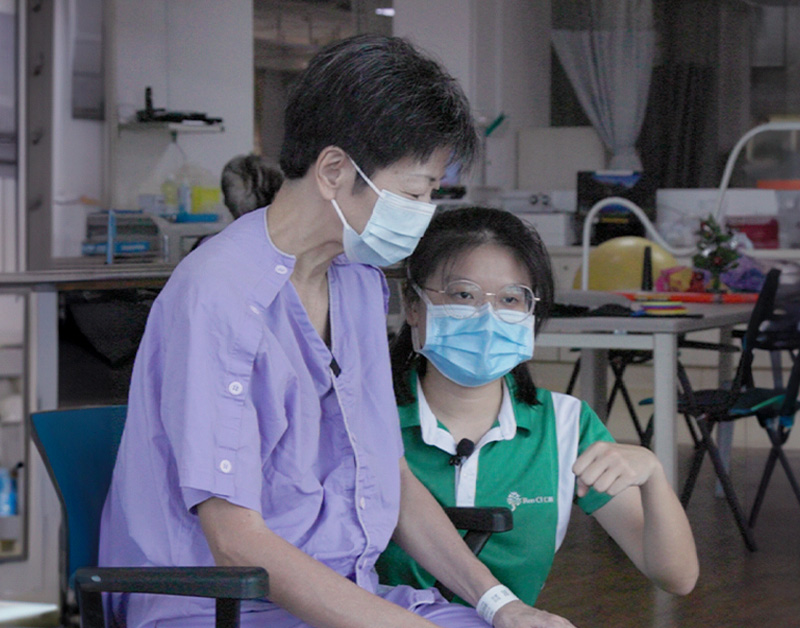Experiencing a sudden loss of mobility or limb function can be profoundly challenging for anyone, whether due to illness or injury. This is especially daunting for the elderly, who tend to face these difficulties more frequently.
At Ren Ci Community Hospital, physiotherapist Miss Yap Li-Ping plays a crucial role in helping patients regain their functional status, and to reintegrate back home and into the community.
Physiotherapists (PTs) are allied health professionals (AHPs) that promote functional recovery through active exercise and rehabilitation therapy. While PTs generally work with patients of all ages from all walks of life, Li-Ping specialises in working with the elderly.
To get a closer look at what a PT does, we sat down with Li-Ping to learn more about how she helps Singapore's elderly get back on their feet again.
Exploring the World of Healthcare
As someone who has always been keen on healthcare, Li-Ping took up numerous job shadowing opportunities during her secondary school days where she learnt about physiotherapy, occupational therapy and respiratory therapy across different healthcare settings. However, among all the therapy groups she had followed, she felt most drawn to physiotherapy.
It was during her job attachments at Ang Mo Kio-Thye Hua Kwan Hospital (AMKTHK) and Ng Teng Fong General Hospital that Li-Ping had the opportunity to be exposed to the work of PTs. While at AMKTHK, she encountered a stroke patient, whose therapy session left a deep impression on her and inspired her to consider pursuing physiotherapy as a career.
“After her stroke, the patient was reluctant to even get down from the bed," she explains, “But the therapist that worked with her was persistent with his encouragement, persuading her that the exercises were beneficial, and that her active participation in the rehabilitation process was necessary for recovery."
“The patient gradually attempted to stand up (from a sitting position on her bed), and she even began light marching on the spot! Throughout the process, the therapist constantly encouraged her and was supportive even though her pace was slow. The difference that the therapist made on the patient in just one session really made an impact on me."
 Li-Ping (third from right) and her peers while job shadowing at AMKTHK
Li-Ping (third from right) and her peers while job shadowing at AMKTHK
To reaffirm her interest in physiotherapy and in working in the community, Li-Ping volunteered at St Luke's ElderCare after her A 'levels. During that time, she was tasked with leading clients in their daily exercise sessions and she enjoyed her interactions with the seniors.
However, what brought Li-Ping the most joy was seeing her clients participate in activities and being physically fit despite their age. As someone with an adventurous spirit and a love for the outdoors, having functional independence was important to Li-Ping.
In fact, her experience at St Luke's inspired Li-Ping to continue motivating and helping others, especially seniors, to stay active and healthy.
“Physiotherapy, to me, offers a special ray of hope: patients see for themselves that part of the power to get well resides in themselves. That hope that accompanies restoration of functional independence is crucial to helping patients live better."
With the collective experiences she had garnered, Li-Ping chose to pursue a 4-year degree in physiotherapy at Trinity College in Dublin, Ireland.
In her third year at Trinity College, Li-Ping came across the Community Care Scholarship (CCS) offered by MOH Holdings (MOHH) in partnership with the Agency for Integrated Care (AIC). The scholarship had a mid-term option and would cover her financial expenses.
Besides relieving a major financial burden, the CCS also opened the door for Li-Ping to work in the Community Care sector — something that she wanted to do after she graduated from Trinity College.
After successfully applying for the CCS however, the COVID-19 pandemic struck Ireland and the rest of the world. Consequently, all overseas scholars, including Li-Ping, were recalled to Singapore. Due to the travel restrictions put in place and the risk of infection, Li-Ping would have to spend the third year of her studies back in Singapore.
Once the threat of COVID-19 subsided, Li-Ping prepared to return to Ireland to complete her fourth and final year. Despite her initial eagerness to resume her studies abroad, she found leaving Singapore again challenging, as she had grown accustomed to being back home, and departed for Ireland with a heavy heart.
Fortunately, the scholarship officers from MOHH were highly supportive and regularly checked in on her when she got back to Ireland.
“It was quite comforting to know that there were people looking out for me back in Singapore," says Li-Ping, “They (the scholarship officers) were always asking me whether I was alright and if I needed any help."
“So, while I was missing home, it was good to have that support during a particularly lonely time in my life."
Caring for The Community at Ren Ci
As a PT at Ren Ci, Li-Ping and her colleagues provide therapy to patients who are admitted with heart and lung conditions to get them back on their feet and return to normal life post-discharge.
To do this, Li-Ping guides patients through gentle aerobic exercises like walking to enhance heart health and endurance. Additionally, Li-Ping helps patients rebuild muscle strength by introducing safe, low-impact exercises that do not strain the heart.
She also teaches breathing techniques and relaxation exercises, which are vital for patients managing stress and anxiety that are often associated with cardiac recovery. These personalised routines not only aid in physical rehabilitation but also boost the overall well-being and confidence of her patients.
At the start of every shift, Li-Ping's will review her patient caseload for the day. Some cases are passed on to therapy assistants after Li-Ping has briefed them while others are handled personally by her.
As Li-Ping and her fellow PTs are part of a multidisciplinary team at Ren Ci Community Hospital, she also cooperates with other allied healthcare professionals such as occupational therapists (OTs). This partnership is essential for providing comprehensive care and facilitating holistic recovery for patients.
For instance, Li-Ping might work with an OT to assist a patient recovering from a stroke. While Li-Ping focuses on restoring the patient's physical mobility and strength through exercises and movement therapy, the OT would concentrate on helping the patient relearn daily living skills, like dressing, eating, and personal grooming.
Together, they develop a coordinated care plan that addresses both the physical and practical aspects of recovery, ensuring the patient regains independence and quality of life. This integrated approach is one example of how PTs and OTs work together to achieve a common goal.
Helping Patients Regain their Independence
About 95% of the patients under Li-Ping's care are above the age of 65. All of them have unique behaviours, attitudes, and motivations. This can result in some patients being fully on board with physiotherapy while others may undergo therapy with reluctance or scepticism.
These behaviours often stem from fear, discomfort, or a lack of understanding about the benefits of physiotherapy. As a PT, it is Li-Ping's job to understand her patients so that they can have effective therapy sessions.
She does this by taking an “out of the box" approach combined with a healthy dose of empathy and compassion.
“It's important to remain gentle and patient, even when patients may be uncooperative," she says, “I always try to remember that sometimes, patients may not immediately follow the therapists' instructions because of fear."
Li-Ping shared that this approach worked well during a case where she was working with a senior who was admitted due to an exacerbation of his Chronic Obstructive Pulmonary Disease (COPD).
During the first few weeks of the patient's admission, he was rather depressed as he was grieving the loss of his mobility and independence. This coupled with his fear of being breathless resulted in him refusing to participate in therapy sessions.
“In this case, it was important to start building a rapport with the patient, and only then would he be receptive to the educational side of physiotherapy."
 Li-Ping connecting with her patient before a physiotherapy session
Li-Ping connecting with her patient before a physiotherapy session
“A large part of the initial physiotherapy treatment was focused on education regarding COPD, as well as the role of exercise in improving and managing COPD. We also taught him breathing techniques and pacing strategies to manage breathlessness on exertion," she says.
Through a combination of education and encouragement, Li-Ping helped the patient build up his confidence to participate in therapy.
The patient responded well to therapy and began recovering which cheered him up immensely. He also opened up to Li-Ping and began sharing stories of his childhood with her.
When the day came for him to be discharged, Li-Ping's patient shook her hand and said goodbye.
“It was heart-warming to witness the drastic change in his emotions and attitude from when he was first admitted to the day of discharge," she says, “This is one of my fondest memories and is a reminder of how we can make a difference in the lives of our patients."
Experiencing the Dynamic Nature of Healthcare
In another case, Li-Ping learnt the importance of staying alert and aware of one's surroundings when working in healthcare.
“I was working with a patient during one of my sessions when his face suddenly paled," she says, “Despite me closely monitoring his blood pressure throughout the session, I saw that he was going to faint."
“It is common for patients to present with a medical condition called postural hypotension, where their blood pressure drops when changing posture, whether from lying to sitting or from sitting to standing," explains Li-Ping, “This causes a drop in blood pressure and may result in symptoms such as dizziness or light-headedness."
When treating such patients, it is vital to measure their blood pressure throughout the session to keep an eye out for drops in blood pressure. A sudden, severe drop in blood pressure can result in the patient fainting due to insufficient blood flow to the brain.
Seeing that the patient was not responding to her calls, Li-Ping called out to her colleagues for help. They quickly brought a recliner wheelchair over and helped the patient to lie back and elevate his legs.
They then immediately transferred the patient back to bed and elevated his legs to encourage blood circulation back to the brain. Thankfully, the patient came around shortly after that much to everyone's relief.
“This incident goes to show that unexpected and/or emergency situations might occur even when all precautions are taken and why it's important to always be aware and alert," says Li-Ping.
Fostering Health and Happiness in Singapore's Community Care
Li-Ping's keen awareness and preparedness for all situations underscore her dedication to patient care, a quality that extends into her work with Singapore's silver generation.
Thanks to advances in technology and better healthcare facilities, the life expectancy of Singapore's general population has steadily increased over time. But this has also led to ageing individuals having to cope with chronic conditions that affect their quality of life.
Because of this, Li-Ping has dedicated herself to motivating and helping elderly members of the community stay active and healthy.
She shares, “In the long-term, I aim to encourage patient compliance, as studies have shown that higher patient compliance often results in better treatment outcomes."
“While the reality is that there may be some cases where full recovery is unlikely, I want to do my best and help patients manage their conditions so that they can live well and with dignity."
Want to find out what Li-Ping does at work? Watch this
TikTok video!
MOH Holdings (MOHH) is currently offering scholarships to nurture the next generation of Community Care professionals. It is offered in partnership with public healthcare institutions and Community Care providers. For more details, check out
this page.